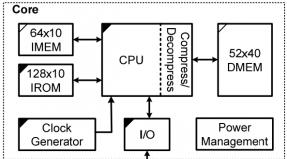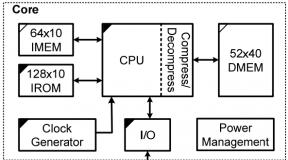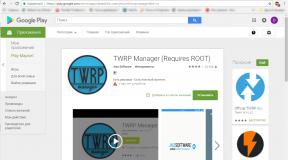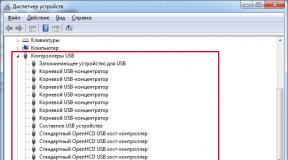How to check the hard drive from a laptop for functionality. Diagnosis and elimination of errors on the hard drive. MHDD program: testing the disk
Hard drives are the most unreliable component of a modern computer. As a rule, modern hard drives last up to 3 years, after which they have to be replaced. The worst thing about this situation is that it is very difficult to predict exactly when the hard drive will fail. Because of this, inexperienced users often lose important data. In this material we will talk about how to check a hard drive for serviceability and correctly assess its condition. Step No. 1. Checking the health of the hard drive using CrystalDiskInfo If you want to check the health of the hard drive, the first thing you need to do is install the CrystalDiskInfo program. This free program collects all available information about the hard drive and, based on it, provides an assessment of its technical condition. If the hard drive is fully operational, then the technical condition of the hard drive will be indicated as “Good”. If there are problems with the hard drive, then you will receive an “Alarm” rating. Well, in cases where the hard drive is on the verge of death, the program gives a “Bad” rating.
You can also view the original S.M.A.R.T data in the CrystalDiskInfo program. (the program uses them to evaluate the state), the temperature of the hard drive, the number of times the hard drive was turned on, and the number of hours worked. Step No. 2. Check the hard drive for errors using the HD Tune program. It is also very important to check your hard drive for errors. The easiest way to do this is to use the free HD Tune program (or its paid version HD Tune Pro). So, in order to check your hard drive for errors, run the HD Tune program, go to the tab and click on the “Start” button.
After this, the HD Tune program will begin checking the hard drive for serviceability. During the verification, you will be able to observe this process. Normal areas of the hard drive will be marked in green, and damaged areas in red.
A fully functional hard drive should not have any damaged (red) blocks at all. Step No. 2. We check the hard drive for service manually. In addition to testing using programs, the hard drive can be checked for service manually. To do this, simply try to write a large number of small files (a couple of megabytes in size) to disk. For example, you might try to copy a large folder of photos to disk.
If the file writing test went well, then try testing how the disk works when reading data. To do this, try copying data from the disk you are testing. Conclusions A fully functional hard drive should pass all three of the above tests without any problems. CrystalDiskInfo should be rated Good, HD Tune should not detect any errors, and manual write/read testing should pass without difficulty. If this is the case for you, then most likely your hard drive is fine and will work for a long time. But, of course, there are no guarantees here and cannot be. Therefore, the only way to reliably protect your data is backup. The most important data (personal photos, videos, documents) should be stored on several hard drives.
Most old hard drives contain erroneous records, etc. . Some of them lead to sad consequences: loss of important files, damage to photos and videos; It's only a matter of time before this happens to your hard drive.
Windows OS offers basic tools for finding errors on the HDD (scandisk, chkdsk), but they are not suitable for diagnostics and testing, checking the suitability of the storage device. We suggest you check out much more effective tools (some of them are free).
The following programs will help you check your hard drive for errors:
Hitachi Drive Fitness Test (WinDFT) – a program for testing and checking the condition of the hard drive
Hitachi Drive Fitness Test is a program for diagnosing a hard drive and finding read errors. The utility allows you to quickly check the status of internal and external hard drives that support G-Technology.
Program features:
- When diagnosing, you can choose a quick or advanced test.
- Next to each test in TestLog, the marks “Pass” or “Fail” are displayed.
- Reading.
- Ability to create a bootable CD image. If booting the OS from the hard drive is not possible, WinDFT can be launched in LiveCD mode.
- Hitachi Drive Fitness Test performs testing without overwriting data on the drive.
Seagate Seatools for Windows: Testing Drive Performance
Seatools from Seagate is a free HDD diagnostic tool for Windows and DOS. The utility will allow you to identify some problems on the HDD before contacting the warranty service to repair the disk (In our realities, instead of repairs, you will be offered a replacement device, as a result of which you will lose all saved data).
Note. The program is not compatible with all HDD models; it is only relevant for hard drives from Seagate.
Problems that the program can detect:
- Violation of the HDD file system structure;
- Bad sectors and reading errors;
- Driver errors and Windows system problems;
- Equipment incompatibility;
- Damage to the Windows bootloader (MBR) on the disk;
- Presence of viruses, keyloggers or other malicious applications.
Seatools works as follows: the user selects tests for diagnostics, runs them, and as a result receives a detailed report. If the test is passed, the PASS mark will be displayed, otherwise FAIL. Please note that HDD testing can take up to 4 hours. To save time, you can choose one of three testing modes.
Seagate Seatools can also be used to “treat” your hard drive. That is, the program is able to detect bad blocks and try to restore or overwrite them with zeros (this method allows you to subsequently ignore problem blocks when reading/writing the disk structure).
Victoria
The Victoria program has long been considered reliable, proven, but at the same time outdated. However, in September 2019, an update was released (the latest version is 4.76b), which introduced several interesting features. Let's note some of them.
- HDD surface testing – Victoria allows you to configure the timeout for the scanner, as well as the block size. The program sequentially reads the data and displays the current state of the disk surface in the form of a color scheme and graph.
- Full support for USB-SATA drives - on laptops and PCs. You can check performance using SMART tests, manage the cache and noise level. Victoria also displays the HDD drive passport in great detail.
- S.M.A.R.T media monitoring. Allows you to evaluate the hard drive for serviceability, degree of wear and HDD reserve - how much longer its resources will last.
- Quick deletion of any information on a disk without the possibility of recovery through repeated “overwriting” and overwriting with “zeros”.

Victoria runs on Windows, including OS version 10, you can download it.
HDD Health program: checking the disk and reading SMART attributes
HDD Health is another free program for testing your hard drive and monitoring its performance. The utility checks the hard drive for errors (SSD / HDD) and makes a forecast (Health indicator as a percentage).
Preliminary check of the disk for errors using basic SMART indicators. HDD Health program interface
The main program window displays the following information:
- manufacturer, model, firmware version
- current HDD (SSD) temperature (available through the notification area)
- general condition of the disk structure
- other attributes (via the Extended info menu)
Similar to other diagnostic tools, HDD Health reads S.M.A.R.T indicators, which allows you to clarify the current hardware performance. The program does not have any other tools for calculating errors or checking for bad blocks.
HDD Health 4.2: checking the status of the SSD disk
Thus, the tools of the HDD Health program will be useful to those for whom S.M.A.R.T. indicators are sufficient to check the condition of the hard drive (and if the condition of the device is not critical). Fortunately, the latest HDD/SSD drives have S.M.A.R.T technology. implemented.
HDDScan - a program to check your hard drive for bad sectors
HDDScan is a free program for hard drive diagnostics, reading S.M.A.R.T. and other parameters. After testing, you will receive a detailed log file detailing the disk status.
HDDScan allows you to check HDD and other storage devices:
- RAID arrays,
- HDD drives with IDE/SATA interface,
- SATA/ATA SSD,
- USB flash drives.
Let's note the most useful functions of HDDScan:
- Checking the hard drive for errors that are not detected by standard Windows utilities: bad blocks and bad sectors
- Testing the hard drive (Read/Wipe)
- Checking the temperature for all hard drives connected to the PC
- Export any information as a custom report
CHKDSK - fixing hard drive errors
You can check your hard drive for errors without installing third-party programs. The Windows operating system (XP, 7, 8, 10) allows you to do this through the Check Disk utility.
The CHKDSK utility appeared in DOS. It not only searches for, but also corrects basic file system errors. It should be clarified that it is not intended to search for all types of errors and is not a HDD diagnostic tool.
However, using CHKDSK you can fix errors on various storage devices: not only on your hard drive, but also on a flash drive and an SD card. Starting with Windows NT, it fixes bad blocks (physically bad sectors) by marking them accordingly. Subsequently, these areas are bypassed by other programs when reading/writing.
HDDLife - a program for monitoring the status of your hard drive
Usually the heart of a computer is called the processor or motherboard. But they serve faithfully for several years, and then the hard drive suddenly fails. In terms of loss, no component can compare with it.
The hard drive is computer memory, which, of course, needs to be protected. In order to prevent sudden data loss, you need to regularly back up your data to another HDD or storage media. However, if you want to prevent hard drive failure in advance, you need to determine its current state. The HDDLife program will help with this.
HDDLife has several very useful features. First of all, monitoring the status of the hard drive. The “health” of the HDD is shown as a color scale. If everything is in order, the scale is green; if the disk has worked for a decent period of time, the color is yellow. The red scale is already a signal of a pre-emergency condition: the hard drive has worked and is ready to retire. In this case, it is better not to take risks and quickly replace the component. In the pro version of HDDLife, you can set up an email notification about the pre-failure state of hard drives. If there are a lot of computers on the network, then the diagnostic option will come in handy. The status graph also informs you how long the disk has been working. This is worth paying attention to, especially if you are buying a used drive or just want to make sure it is new.
The second important section is displaying the disk temperature. Any electronics works, or rather wears out faster, at elevated temperatures. And too high a temperature, as a rule, leads to disastrous consequences. If the indicator text is green, then everything is in order and the disk is in good thermal conditions. Otherwise, you need to buy special cooling or check the ventilation of the slot in which the disk is located. On some HDDs, the program allows you to adjust the noise level and performance. This is done using a slider that determines the relationship between the characteristics. Either this is the possibility of a special version for a laptop, or a limitation of the trial version - however, the option was not available for us. Some HDDLife features cannot be called unique: for example, an indicator of available space. If there is not enough space on the partitions, the now familiar warning is displayed. Free space monitoring is available in Windows, as in almost any OS, so the message is more annoying than informative.
The program is distributed in three versions: free, HDDLife Professional and HDDLife for Notebooks. The differences can be found on the page http://www.hddlife.ru/rus/compare.html.
Western Digital Data Lifeguard Diagnostic - a program for checking a disk for “professional suitability”
If you are using a Western Digital HDD or SSD, this program will be useful for diagnostics.
This product can be used as a desktop application for Windows, or as an ISO image that will help you explore your hard drive without loading the OS,
Available options:
- viewing self-diagnosis indicators - SMART attributes,
- checking bad sectors on Western Digital hard drives,
- complete deletion of information on the HDD - erasing with “zeros”.
The program is available on the official website of Western Digital at the link.
HDD Regenerator – a program for testing the hard drive and treating bad sectors
Attention!!! HDD Regenerator cannot restore bad sectors and files. The program is best suited for these purposes. Judging by the feedback from visitors to the IXBT forum, the functions of HDD Regenerator do not correspond to the stated ones.
HDD Regenerator is a utility for checking a hard drive, a professional tool for diagnostics and error detection. The word "Regenerator" is deceptive: the program is able to detect possible faults, but it will not be able to correct structural and bad sector errors.
HDD Regenerator program interface
First of all, HDD Regenerator is a program for checking the hard drive for errors in the sequential block reading mode. If the information is not readable, “regeneration” will allow you to bypass bad blocks and read problematic files.
In order to determine the condition of the HDD, you must pass a special test. Additional information can be retrieved. HDD Regenerator has the corresponding tools.
Other features of the program:
- FAT and NTFS file systems are supported; however, when testing, the file system format does not matter;
- Displaying detailed statistics about the current state of the hard drive and its performance;
- Creating a bootable regenerating USB flash drive or CD/DVD based on HDD Regenerator;
- Prescan mode: quick diagnostics of the hard drive (surface scanning);
- Monitoring HDD operation in real time;
- Data security: the program works in read mode (with the exception of overwriting bad sectors).
The cost of the PRO version of HDD Regenerator is $79.99/year. There is a free trial version available that allows you to “regenerate” 1 bad sector for free. However, what is meant by the word “regeneration” is unclear. You can use this mode at your own peril and risk, only if you are not afraid of losing your data completely.
Answers to readers' questions
I often resort to system recovery due to a crash. It often freezes, the processor is constantly overloaded, I have already deleted unnecessary programs. As best I could, I closed all background programs. Experts say that you need to change the hard drive, they say, there are many damaged (broken) sectors. I want to try this program to check sectors. How to check your hard drive for errors?
Answer. Indeed, if you experience the problems described in your question, checking your hard drive for bad sectors will not hurt. At a minimum, we recommend scanning the disk using applications such as HDD Regenerator and Victoria. You can find out how to check your hard drive for bad sectors directly in the documentation. Whether it’s worth it or not, the wording is not very correct. You should check your HDD for errors regularly if the data is of even minimal value to you.
First! All your programs are not Russified, which creates inconvenience in use, long inaccurate translations and work on a whim. My hard drive problem is an I/O error on the device during initialization. I don't need the data. Sector 0 is normal, the rest need to be restored. There is no physical or other damage, it displays technical parameters well, there is no overheating. I assume that with the help of HDD Regenerator everything can be corrected or by editing the sector record manually using programs that provide this opportunity, it is a long procedure, so something faster is preferable. Seagate Barracuda 1T drive! All the best to you and good luck!
Letter. A difficult question for the site administrator and please answer in simple language, so that a simple user can understand.
How to check your hard drive for functionality, and most importantly, is it possible to remove bad sectors from a hard drive, or what are they also called, bad blocks, which, as it turns out, come in several types:
– physical (crumbling magnetic layer of working plates, chips, etc.),
– logical (sector logic errors), logical bad blocks, can also be classified as software bads, that is, soft bads (file system errors).
Before writing to you, I spent quite some time understanding this issue and realized that the average user knows superficial and inaccurate information, namely: many people believe that all bad sectors or bad blocks are removed by normal formatting, but this is not so. It turns out that it is generally impossible to remove physical bads, but logical ones only with the help of special programs, and only software bad blocks or soft bads (file system errors) can be removed using ordinary Windows tools, for example, using or regular formatting. What am I talking about?
Recently I had to contact a service center about strange behavior of my computer. Firstly, there were periodic freezes, lasting several seconds, and sometimes permanently; I had to restart the computer with the Reset button. Occasionally, strange clicks and creaks were heard from the hard drive. Strange folders with no names were found in the system. The simple process of copying a file from one hard drive partition to another took an terribly long time. Also, the operating system often checked the hard drive for errors when turning on the computer, and the last time it showed BOOTMGR is missing on a black screen, I recovered this error using the seven installation disk, but a day later when loading the computer it just showed a black screen, I thought enough was enough and contacted the service center.
At the service center, a technician checked my hard drive using the free HDDScan program.
Unfortunately, the master checking did not explain anything, he showed me only after checking the presence of 12 bad blocks (English: bad sector, bad block, bad sectors - damaged), marked by the program in blue. Another 90 sectors were marked in red; they were not yet bad blocks, but their response time was not good, more than 500 ms.
The wizard also showed me the S.M.A.R.T of my hard drive and recognized it as not very good, since the most important parameter is Reallocated Sector Count - indicating the number of reassigned sectors (when the disk detects a read/write error, the sector is marked “reassigned”, and the data from the damaged sector or in other words, the physical bad block is transferred to the backup area), is almost critical, it is responsible for physical defects of the hard drive that cannot be corrected.
Another parameter, Current Pending Errors Count, which is responsible for the number of sectors that are difficult to read and very different from reading a normal sector, was also marked in yellow, which indicated its poor condition. The expert’s advice was: Transfer all important data from the hard drive and “fix” it in this HDDScan program, but since there are a lot of bad blocks, most likely it will not be possible to fix all of them and it will no longer be possible to install the operating system on it, in In the future, you need to use this hard drive as a file storage or, as they also say, a file trash bin, this is the only way it will survive for some time.

I listened to the technician and left the hard drive at the service center for “treatment” until the evening, and in the evening I was shown the result.
Not a single bad sector (bad block), but there were 12. The number of sectors with a response time of more than 500 ms has become smaller (from 90 to 23),

one of the critical S.M.A.R.T indicators is 197 Current Pending Errors Count-responsible, as I already said, for the number of sectors that are difficult to read, has become normal, the parameter 198 Uncorrectable Errors Count-the number of uncorrected errors when accessing a sector also became within the normal range, but the most important indicator, according to him, Reallocated Sector Count, did not change and remained unsatisfactory, so the conclusion is this: the operating system cannot be installed on this hard drive.

And now I have a question for you, please explain in detail, how to check hard drive for professional suitability on my own, how to determine how many bad sectors I have and what they are? How to use programs like HDDScan, and most importantly, how to get rid of bad blocks using it. What exactly does the program do with the hard drive, ridding it of bad blocks, and how long will such treatment of the hard drive help? Is it still possible to install an operating system on this hard drive or not? And the last question, the incorrigible parameter S.M.A.R.T - Reallocated Sector Count can still be corrected and whether physical bads are actually incorrigible at all, many forums on the Internet say that there are proprietary utilities of hard drive manufacturers that can perform low-level formatting at home. Alexander Anatolyevich. Tomsk.
How to check your hard drive
Friends, let's keep it short - sister of talent, one of my friends, having read this question, answered it like this:- “You can’t cover up a scratch with anything, but a software problem can’t be cured.”
The topic is not simple, but relevant, the article is long, but I tried to make it understandable to the average user. To make everything easier to understand, I suggest, along the way, step by step, using the free HDDScan program, to check the MAXTOR STM3250310AS hard drive installed in the computer that was brought to our service center for repair. The operating system installed on the hard drive freezes from time to time, refuses to boot, displays various errors or just a black screen. The hard drive creaks and clicks (I’ll explain why below). Reinstalling Windows did not help the matter and the owners of the computer do not know what to do.
So how to check the status of a hard drive? This can be done using various tests in the HDDScan program. First, let’s check the S.M.A.R.T indicators of this hard drive, then we’ll test the surface of the hard drive, we’ll find no less than 63 bad sectors and our program will fix them all, how long will last is another question (read on).
- But first, a very brief information about how a hard drive works, if this digression is not made, you simply will not understand the principle of operation of the HDDScan program and other similar programs, much less you will not understand what S.M.A.R.T is, as well as bad sectors (bad blocks) and why some of them cannot be fixed.
The hard drive is made of aluminum or glass plates coated with a layer of ferromagnetic material. A hard drive is primarily a device that operates on the principle of magnetic recording. Magnetic heads that read, write or erase information from a hard disk hover above its surface at a height of 10-12 nm and never touch the surface of the magnetic disk, which is easily damaged.
- At the final stage of hard drive production, low level formatting, that is, tracks are applied to the working plates of the hard drive, each track is divided into sectors. Also, special magnetic servo marks are applied to the magnetic surface of the hard drive; they are needed to accurately place the magnetic head of the hard drive on the tracks of the hard drive. The minimum unit of information on a hard disk is a sector; the volume available to the user is 512 bytes of data. Low-level formatting in the life of a hard drive occurs only once, friends, and only on special and very expensive factory equipment - called Servowriter. Information recorded using this formatting will never be overwritten. Friends, such formatting cannot be done in any service. Therefore, my answer to the question whether it is possible to carry out low-level formatting using the operating system is the answer - no, it is not possible. Low-level formatting can only be done at the factory; it even destroys tracks, sectors and magnetic servo marks. For example, in the program Victoria erases all the information on the hard drive by filling all sectors with zeros, this cannot be called low-level formatting, but it cannot be called formatting either, it is something in between. After Write mode, all sectors of the hard disk are filled with zeros and do not contain any errors, and it can be formatted into a file system using Windows.
- At the factory, only service information is recorded in sectors ( servo information servo service, for example, the physical address of the sector and the address marker that determines the beginning of the sector), this information can be called markings, it is needed for the normal operation of the hard drive, this is information about the numbers of tracks and sectors, necessary for the heads to accurately hit these tracks and sectors when reading information written in them.
After purchasing a hard drive, user data will also later be written to this area (for example, the first sector of the hard drive will contain the MBR master boot record), but User data can be recorded and erased, in contrast to service information, which has much greater magnetization, which is why the read-write heads of the drive can't erase it.
All service information about track and sector numbers will be stored in a special table located in a closed service area, inaccessible to OS and BIOS tools, which is a mini-operating system; together with the Firmware, they control the operation of the hard drive. Sometimes they ask the question - Is it sometimes necessary to update the firmware of a hard drive, the answer is negative, modern hard drives do not need updating. Also in this service area the disk passport, SMART attribute values, as well as a defect table with information about unrecoverable or reassigned bad sectors (bad blocks) will be stored.
So we got to the physical, logical and software bad sectors.
![]()
The fact is, friends, that if the operating system has problems reading data from a sector, then the hard drive controller makes several additional attempts to read the data, if they are also unsuccessful, this sector is recognized as faulty, and then the information is written to the normal sector , located on the backup track, and the problematic sector is recognized as faulty and removed from circulation, this is called (Remapping, in common parlance remap).
- Friends, whether to perform a remap or not is decided only by the hard drive controller during operation, and not by any programs for working with the hard drive (Victoria, MHDD). These programs can only hint with their tests (for example, Advanced REMAP in the Victoria program - an improved algorithm for hiding bad blocks) to the hard drive controller that a remap needs to be done.
The fact that a sector is recognized as faulty is entered into the defect table with information about unrecoverable or reassigned faulty sectors, located in the service area.
By the way, there are two tables of defects, one is the initial P-list (Primary-list), created after the final factory tests; any hard drive, friends, already has several reassigned bad blocks when it leaves the factory. Well, the growing table of defects G-list (Grown-list) is filled in by us as we use the hard drive.
What are bad sectors and how to fix them?
- Physical bad sectors are mechanical defects in the magnetic coating of the hard drive surface (crumbling magnetic layer of working plates, chips, etc.). That is, the sector structure itself is physically faulty; undoubtedly, such a bad block must be reassigned as a normal sector from the backup track. Very often this happens due to an impact caused, for example, by dropping a hard drive on the floor, mechanical damage occurs to the magnetic coating of the hard drive, damage to the magnetic heads, the same can happen due to overheating. Vibration of a hard drive is also dangerous if it is not securely fastened. A dusty room, smoking, despite the filter installed in the hard drive, also play a huge role in the formation of bad blocks; tobacco tar and dust stick to the surface of the hard drive and interfere with reading information.
- Physical bad blocks are not possible cannot be corrected by any formatting, you can only reassign them as spare sectors from the reserve tracks; naturally, because of this, the performance will drop somewhat, since the magnetic head of the hard drive will have to make many additional movements, looking for information on the reassigned sectors from the reserve tracks.
Why does the hard drive squeak? and sometimes clicks when working
When the operating system encounters a bad sector, the hard drive controller makes several attempts to read information from it, while clicks and squeaks may be produced by the hard drive head positioner.
The following reason may also be the cause of clicks and squeaks of the hard drive. When reassigning a bad sector to a normal one from a backup track (which is not always nearby), the magnetic head naturally has to change direction, as many say jump from side to side.
The third reason is that, as I said above, during the manufacture of a hard drive, special markings are made on the magnetic surface of hard drives with special servo marks; these servo marks are used to accurately position the magnetic head on the tracks of the hard drive; it is with the help of servo marks that the magnetic head of the hard drive moves correctly. Sometimes servo tags are destroyed for the same reasons that physical bad blocks are formed and the magnetic head cannot take and hold the position it needs, and clicks and creaks are heard from the hard drive.
- Logical bad blocks(sector logic errors), in turn divided into correctable and incorrigible. In which case logical bad block cannot be fixed? As I said above, each sector, in addition to user information, also contains service information (servo information, for example, the physical address of the sector and an address marker that determines the beginning of the sector), in simple words, markings with the help of which the magnetic head of the hard drive gets to the necessary tracks of the sectors, such markings applied by low-level formatting at the factory during the manufacture of the hard drive. This information is almost impossible to delete since it is highly magnetized, but under certain circumstances, similar to the reasons for the appearance of physical bad blocks (shock, vibration, bearing play, etc.), this information is violated and can only be restored in the factory. Yes, there are special proprietary utilities that overwrite service information, but due to the complexity of their use, this issue is difficult even for specialized specialists and we will not consider it.
- Logical bad blocksthat can be fixed. When writing to the user information sector, a piece of service information is additionally written, the so-called ECC (Error Correction Code) sector checksum; this code allows you to restore data if it was read with an error. But sometimes this code is not written, and accordingly the sum of user data in the sector does not match the ECC checksum. One simple example of why this happens is a sudden shutdown of the computer due to an electrical failure, because of this, information was written to the hard disk sector, but the checksum was not. The next time the operating system accesses this sector and tries to read data from it, but it will not match the ECC checksum, an attempt will be made to read the data again and again without success (so you get freezes and a bad block).
- Software bad blocks(file system errors - for example, an incorrectly marked sector belonging to two files) can be removed using the operating system - more reliably by regular formatting.
You will say that all this is good and understandable, but how can you get rid of bad blocks, transfer data from the hard drive and format it in the operating system installation program?
When formatting using all the methods available to the operating system, the same attempt will occur to read information from the bad sector, then compare them with the ECC checksum, but it does not match, which means that the incorrect information will not be overwritten and the bad sector will remain bad even after formatting. So it turns out that you need a special program, for example МHDD or HDDScan, which will not read anything, but will simply force a rewrite, usually filling the bad sector with zeros, but then it will read what was written down and compare the checksum, after which the sector will return to work.
For example, the HDDScan program has an Erase function - Test in linear recording mode (sector-by-sector erasing of data), carefully all your data will be deleted. Unfortunately, nothing will work without deleting the data, so before this test it must be transferred to another storage medium.

The best thing is to completely remove your hard drive and connect it to another computer that has the HDDScan program, then run the Erase test and check your entire hard drive. You don’t have to remove anything, burn boot disks with MHDD or Victoria programs, boot from them and run these programs with the Advanced remap function, but we will do this in other articles.
Now, friends, let's move on directly to working with the HDDScan program. With the help of this program, we will see the full picture of what is happening with our hard drive, namely, we will find out the S.M.A.R.T of our hard drive and decrypt it, we will also set the number of bad sectors and of course we will try to fix them.
Continue reading the article
Do you want to know how to earn 50 thousand monthly online?
Watch my video interview with Igor Krestinin
=>>
Why is the check carried out?
It is necessary to check the operation of the internal memory media then:
- When you purchased a new hard drive for your PC.
- If you notice poor computer performance. This could be: loss of folders and files, lengthy copying and transfer of files from one hard drive storage location to another, frequent application freezes.
- If noise occurs when working with a computer.
The internal memory storage is checked using special programs. The most effective of them are scanning utilities - HDD Scan and Victoria. The first program is capable of fully checking the hard drive and producing a result that will indicate the status of all storage media:
- IDE/SATA/SCSI;
- USB/Firewire (external drives);
- RAID arrays;
- flash cards.
HDD Scan will tell you the series and firmware number of the hard drive that is installed on the PC. The utility is able to scan and find flaws and damage on the internal memory of your PC. HDD Scan will also determine how full the hard drive resource is.
Every student can know how to check a hard drive for functionality using the HDD Scan program. This is the easiest way to detect hard drive damage. You need to download the program to your computer and download the check. The utility offers a simple menu that does not require additional explanation.

You can download the program by clicking on the “Download Version” button. After downloading the utility to your computer, unzip the files. Now go to the program folder, running the executable file. This program does not require mandatory installation, and the file with the multifunctional utility takes up a tiny amount of space on your hard drive.
A method for diagnosing and cleaning a hard drive (Victoria)
As you use your computer's hard drive, its performance characteristics are lost over time. In this regard, so-called “broken sectors” can form on hard drives.
This process foreshadows the aging of the internal storage resource and it is inexorable. These problems are characterized by a decrease in hard drive performance and loss of information from the disk. Having identified a problem, it is necessary to solve it.


Do you want to know what mistakes beginners make? 
99% of beginners make these mistakes and fail in business and making money on the Internet! Make sure you don't repeat these mistakes - “3 + 1 ROOKIE MISTAKES THAT KILL RESULTS”.
Do you urgently need money? 
Download for free: " TOP - 5 ways to make money online" 5 best ways to make money on the Internet, which are guaranteed to bring you results of 1,000 rubles per day or more.
Here is a ready-made solution for your business! 
And for those who are used to taking ready-made solutions, there is “Project of ready-made solutions for starting to make money on the Internet”. Find out how to start your own business online, even for the greenest beginner, without technical knowledge, and even without expertise.
If the HDD makes strange sounds or there are problems with writing and reading information, you should use one of the programs to check the hard drive for errors. Depending on the task (checking the disk surface for damage, searching for bad sectors, correcting errors, etc.), different software may be useful.
You can quickly check the disk for errors using standard system tools, but to restore the hard drive you will need special third-party programs. Having learned how to check the health of a hard drive using various utilities, a user of any level will be able to cope with problems that arise.
CheckDisk System Service is the simplest hard drive diagnostic program that can't find complex errors or fix bad sectors, but is useful for fixing basic problems. It is available on all versions of Windows OS and can be used to check drives of any type. All users need to know how to check a hard drive for errors with this tool.
The graphical interface version of the utility is most convenient for novice users. You can launch it through the disk management menu, which can be accessed in two ways:
- in Windows XP/Vista/7 - select “Manage” in the context menu of “My Computer”, then go to the desired menu;
- in Windows 8/10 - press the Win+X combination and select the appropriate item.
In the window that opens, select the device that needs analysis, right-click on it and select “Properties” from the drop-down menu. By going to the “Service” tab, you need to run the hard drive diagnostic program.
The system will check and automatically correct errors if the disk is not currently busy with read or write processes. Otherwise, the program will offer to test after rebooting the PC. If necessary, in the scan results window you can see detailed information about the status of the HDD.
The GUI version does not always help, since checking the status of the hard drive is sometimes required from safe mode or without starting the operating system at all. In such cases, the console comes to the rescue; you can launch it before the system starts using a boot disk.
Once you open the recovery console, you need to run the chkdsk /f command, which will check all connected drives. In some cases, this will help fix the error. However, in most situations, if a HDD failure has made it impossible to start the system, a more in-depth check of the condition of the hard drive will be required.
To use the console command from inside the system you need to:
- launch the command line (via Win+X or by entering cmd in the “Run” window);
- enter the chkdsk command indicating the letter of the partition being checked and additional flags;
- Confirm the operation by pressing Y.
Checking the HDD via the command line will be a little faster than using the GUI version of the program; the results will be shown here in the console.
The Linux system also has standard tools - hdparm and smartctl, launched from the console.
Simple programs for quickly checking HDD
If standard utilities are not suitable, hard drive diagnostics can be carried out using simple third-party programs. They allow you to obtain more information about the health status of the HDD, but in case of serious problems they will not be suitable, since they cannot be used to fix the damage.
HDDScan is a free program that performs analysis in two modes:
- according to S.M.A.R.T. indicators;
- linear processing.
The tool evaluates the read and write speed of various sectors, marking the “slow” cells. During the analysis, the program ensures that the tested hard drives do not overheat; at the end of processing, the user is presented with a full report.
HDDScan good versatility. The utility allows you to check disks for errors regardless of the type of device: it can either check an external hard drive or analyze a RAID array, SSD drive or memory card.
Crystal Disk Mark has only one function - it evaluates the read and write speed. Despite this, it is often used, since it is still possible to check the hard drive for serviceability using just two indicators.
The test uses different algorithms, one of which is sequential recording mode. The program gradually fills all the space on the drive with blocks of a size specified by the user, after which it cleans the HDD. The same technique is used by hard drive manufacturers to check product quality. Its disadvantage is that it accelerates the wear of SSD drives.
CrystalDiskInfo And DiskCheckup They are similar in their set of functions, differing only in the interface. They check the status of the hard drive using S.M.A.R.T. algorithms and compile a history of checks, which allows you to track the dynamics of changes. CrystalDiskInfo has more options for visualizing history. For example, you can create a graph, not just get a written report.
Another feature of these programs is a convenient notification system. In-depth hard drive tests usually take a long time. If the user needs to step away from the computer, he can enable notifications of critical HDD errors via E-Mail.
Programs from hard drive manufacturers
Some HDD manufacturers have developed their own utilities for analyzing the status of the hard drive. They are intended for use with devices of the same name; diagnosing a hard drive from another company is possible with their help, but this must be done carefully. Unlike simpler programs, these utilities have versions in different languages, including Russian. Which program is better to analyze the HDD status?
The proprietary program from Seagate exists in two versions: a standard version for running under Windows and a DOS version in ISO image format, from which you can make a bootable USB flash drive. It is recommended to use the second option, since the check in this case will be more accurate and efficient.
SeaTools uses part of the S.M.A.R.T indicators. to test the hard drive without giving away details about each item. Three tests can be performed:
- short self-test of HDD;
- short rapid test;
- a long-term check in which all sectors are read sequentially.
As the scan progresses, the program automatically corrects any errors found.
Owners of hard drives from WD should know how to check the performance of hard drives using proprietary software from this manufacturer. The range of its capabilities is similar to that of the program from Seagate, but is somewhat expanded and allows for deeper work with the affected device.
There are two additional functions:
- deep disk formatting - the program writes zeros to all sectors, permanently destroying information;
- blocking access to bad sectors - the program marks bad blocks, preventing the writing of new information to them.
Unlike SeaTools, this HDD diagnostic program can be freely used with devices from any manufacturer to check the hard drive for errors - no problems were identified with this.
Deep testing software
If you need not only checking the hard drive for errors, but also correcting bad sectors, you cannot do without sophisticated software that carries out the most in-depth analysis of the HDD state.
Victoria HDD
According to many users, Victoria HDD is the best software for detecting hard drive problems. The program gained this reputation due to its wide range of functions.
Victoria exists in two versions:
- with a graphical shell for use from inside Windows;
- with a DOS shell to create a boot disk.
It's better to use the second version. Diagnostics of the HDD outside the system allows you to achieve better results, so it is always recommended to follow the principle “if possible, test the disk from the boot disk.” As a last resort, you can use a LiveCD of another OS, for example, a Linux distribution like Ubuntu.
Victoria HDD has a variety of functions:
- quick and complete disk scan;
- reassignment of bad sectors and their restoration;
- checking the status of contacts in the IDE or SATA cable;
- equipment performance analysis;
- viewing S.M.A.R.T. indicators.
When checking, you need to pay attention to the access time to sectors. It should not exceed 200-600 ms. You can also view the temperature of the disk during operation, but this is not so important.
HDD Regenerator
HDD Regenerator is a program for professional hard drive recovery. It not only marks bad sectors as unused, but also tries to revive them. For this, not the standard deep formatting method is used, but a proprietary algorithm based on transmitting signals of different levels to the sector. Despite its professional level, inexperienced users can also use this software, since testing a hard drive with its help is not difficult thanks to its convenient Russian-language interface.
Program features:
- ensuring data safety - it works only in read mode;
- support for different file systems;
- the ability to scan the disk surface;
- real-time monitoring.
The program is not suitable for everyone, since you can check your hard drive for functionality for free, but you will have to pay $90 for the sector recovery function.
If you don't want to pay, you can use TestDisk, a free program that can restore the partition table, boot sectors and MFT. It also detects bad sectors, can recover deleted information and fix file system errors. The only drawback is the lack of a graphical interface; you have to work from the console.
If, after checking the HDD and correcting all problems, the computer does not stop working incorrectly, it is worth checking the registry. Perhaps the failures are caused not by hardware failure, but by internal system errors.


















